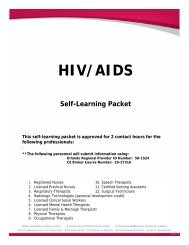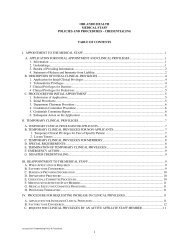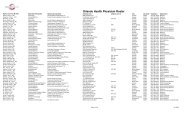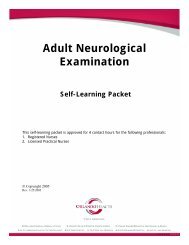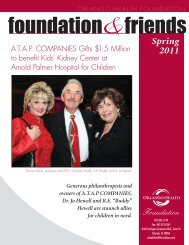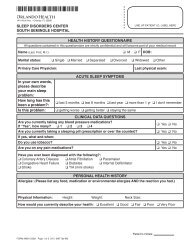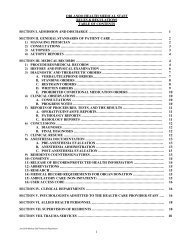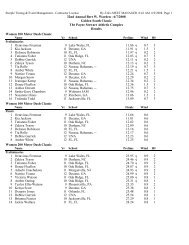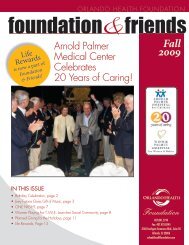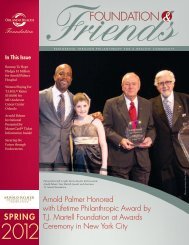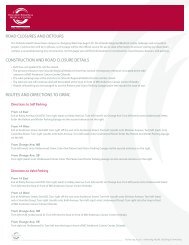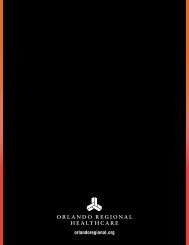Introduction to CV Pharmacology - Orlando Health
Introduction to CV Pharmacology - Orlando Health
Introduction to CV Pharmacology - Orlando Health
Create successful ePaper yourself
Turn your PDF publications into a flip-book with our unique Google optimized e-Paper software.
<strong>CV</strong> <strong>Pharmacology</strong><br />
Vasopressor Therapy<br />
Clinical Application<br />
Vasopressor drugs must not be used until the patient’s volume status has been addressed.<br />
The administration of vasopressors <strong>to</strong> hypovolemic patients does not increase blood<br />
pressure; instead it can result in profound tachydysrhythmias and ventricular tachycardia or<br />
ventricular fibrillation.<br />
Should extravasation of this or any other alpha agonist occur, phen<strong>to</strong>lamine (Regitine) may be<br />
used <strong>to</strong> help minimize tissue damage. Refer <strong>to</strong> your hospital’s policy regarding the use of<br />
phen<strong>to</strong>lamine for intravenous extravasation of these drugs.<br />
Dopamine<br />
Dopamine (Intropin) is a chemical precursor of norepinephrine. Dopamine stimulates alpha, β 1 ,<br />
and dopaminergic recep<strong>to</strong>rs, depending on the administered dose, and also stimulates the release<br />
of norepinephrine<br />
Indications<br />
Dopamine is used primarily for symp<strong>to</strong>matic hypotension and <strong>to</strong> increase organ perfusion.<br />
According <strong>to</strong> the ACLS bradycardia algorithm, dopamine may also be considered in<br />
hemodynamically significant bradycardia, with the dose beginning at 5 mcg/kg/minute,<br />
following the use of transcutaneous pacing and/or atropine.<br />
In patients with cardiogenic shock, left ventricular failure, and pulmonary edema, dopamine may<br />
be used in conjunction with positive inotropic agents and vasodila<strong>to</strong>rs. This permits the<br />
beneficial β 1 effects <strong>to</strong> predominate and counteracts the increases in preload and afterload caused<br />
by alpha stimulation.<br />
At low doses (1 – 4 mcg/kg/minute), dopamine stimulates the dopaminergic recep<strong>to</strong>rs <strong>to</strong> produce<br />
cerebral, renal, and mesenteric vasodilation. This dose is commonly thought <strong>to</strong> increase blood<br />
flow <strong>to</strong> the kidneys and may sometimes be referred <strong>to</strong> as the renal dose dopamine. The efficacy<br />
of dopamine for this indication is not supported in the literature.<br />
NOTE: Many clinicians currently suggest that low dose dopamine therapy does NOT prevent or<br />
ameliorate acute renal failure in patients.<br />
At moderate doses (5 -10 mcg/kg/minute), dopamine stimulates the β 1 recep<strong>to</strong>rs in the<br />
myocardium. This increases contractility, cardiac output, and arterial blood pressure.<br />
At higher doses (10 – 20 mcg/kg/minute), the alpha agonist properties of dopamine are much<br />
more pronounced, resulting in significant increases in peripheral and venous vasoconstriction.<br />
This results in an increase in preload, afterload, and myocardial workload. It also significantly<br />
increases myocardial oxygen demand and negates the positive β 1 and dopaminergic effects.<br />
At doses of 20 mcg/kg/minute or more, significant arterial vasoconstriction results. If<br />
hypotension continues, then other interventions should be considered.<br />
2010 <strong>Orlando</strong> <strong>Health</strong>, Education & Development 35



